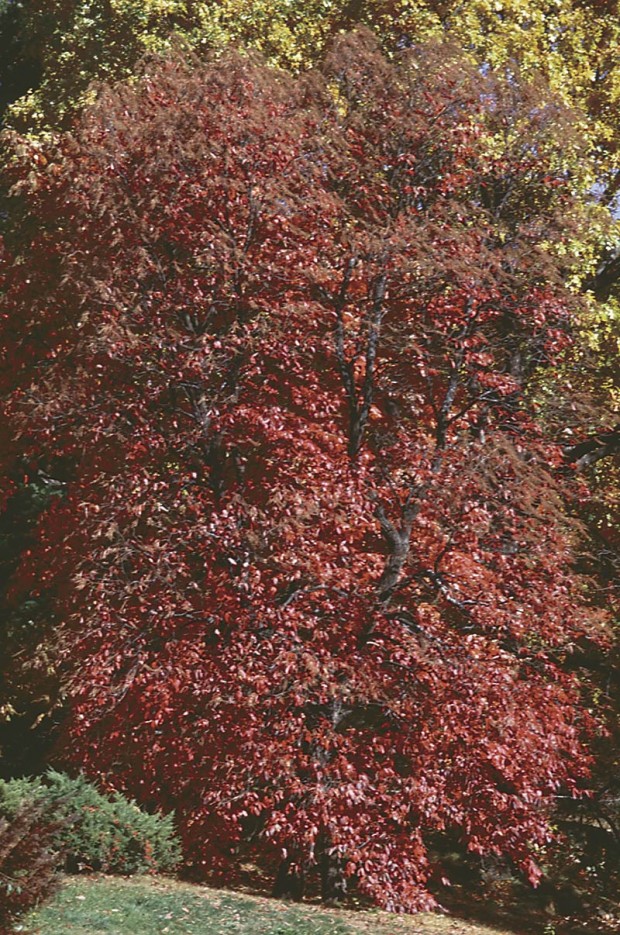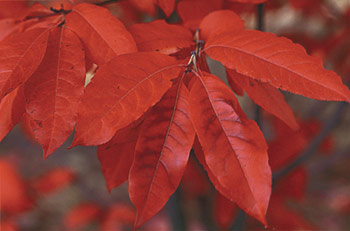
by Eric Grant
The autumn winds of October bring thoughts of pumpkins, apple cider and hay rides. The season is announced with the anticipation of a kaleidoscopic array of fall colors. These changing hues celebrate the landscape at one of its finest moments. Few trees can herald the autumnal change with the vibrancy of sourwood (Oxydendrum arboreum). Sometimes called the sorrel tree (referring to its leaves), or lily of the valley tree (for its blooms), fall is only one of four outstanding seasons for this little known tree of wonders.
“Spring green” must have been defined by the foliage of this tree. Its soft, but stately outline breaks the winter rest by cloaking itself in the freshest shades of green. Its glossy foliage always seems to shimmer as it progresses through its rainbow range of color. When other flowering trees have finished their brief show, sourwood is about to embark upon a stunning and extended display of fragrant blooms. By mid June, the branches of this tree are generously graced with delicate fronds, which gently hang amidst the now dark green foliage. These creamy white panicles are abundantly tipped with small white “bells” offering an effect not unlike Victorian lace thoughtfully woven throughout the canopy. Sourwood is a tree that refuses to leave its glory with faded flowers. It continues to build its drama beyond the blooms, which last for weeks. Even once the flowers fade, the skeletal lace that held them remains for months, and continues to endow the tree with visual pleasure from the end of spring to beyond the autumn. This is a showy feat upheld by few other trees.

Now comes October. Sourwood is in the midst of act three. The performance is one of color and form, which on its own upstages burning bush, sugar maples, and other outstanding fall color plants. In their presence, however, sourwood only stands to enhance and compliment their beauty. This tree now offers a vibrant display of yellow and purple splashed amidst its predominant color—one of the most brilliant reds I’ve seen on any plant! The intensity of color is richly translucent and always draws remarks of awe. By October’s end, even though it will have dropped its leaves, sourwood does not abandon aesthetic pleasure. As winter winds approach, it again reveals its soft structure and its dark and furrowed bark, a most appealing silhouette against the winter snow. It waits in rest, to begin its cycle again, secure that its series of encores will never disappoint its audience.
Native from the Midwest into the Smoky Mountains, this problem-free tree will mature to 25 feet or so. Given its medium size and a slightly rounded, pyramidal shape, it is easily incorporated into most landscape settings. It enjoys full sun, but tolerates light or dappled shade equally well, and is often found thriving along woodland borders. Sourwood performs well in average to acidic soils, and from loamy peat to sandy beds. While it prefers relatively moist soils, once established, it can even withstand dry seasons. This tree appreciates some shelter, but for the Michigan gardener, is generally less temperamental than dogwoods or magnolias, which are more common flowering trees of comparable size.
Sourwood is a tree of prominence in any season and deserves consideration in the modern landscape. It is rewarding to find a plant with so many attributes that has not been overused. In fact, as one of landscape’s best kept secrets, its novelty offers one of the highest prizes for gardeners—this is a plant your neighbor doesn’t have!
Sourwood
Botanical name: Oxydendrum arboreum (ox-ih-DEN-drum ar-BORE-ee-um)
Plant type: Deciduous tree
Plant size: 25-30 feet tall, 20 feet wide
Growth rate: Slow
Habit: Pyramidal shape, with drooping branches
Hardiness: Zone 5
Flower color: White
Flower size: 1/4 inch long on 4- to 10-inch long clusters
Bloom period: Summer
Leaf color: Green in spring, turning to dark green; red, yellow and purple in the fall
Leaf size: 3-8 inches long, 1-1/2 to 3-1/2 inches wide
Bark: Grayish brown to black
Light: Full sun to partial shade. Flowering and fall color are best in full sun.
Soil: Well-drained, average to acidic, moist soil. Does fairly well in dry soils.
Uses: Specimen tree
Remarks: Native American tree; four-season interest.

Leave a Reply